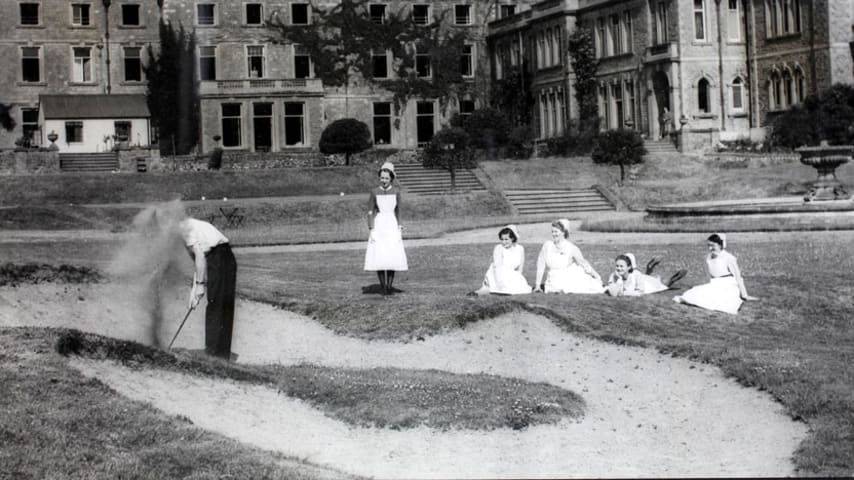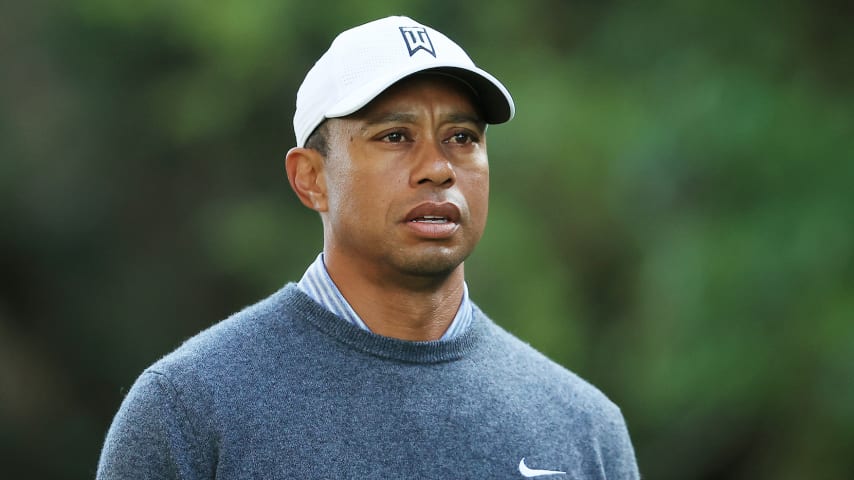How golf has handled previous global crises
9 Min Read

Written by Jim McCabe
We have been here before. Not us; our society. And eerily mirroring the influenza pandemic from nearly a century ago, these days we are not only fighting an invisible enemy, we are wrestling with emotional decisions on what is right and wrong.
The answers now, as then, aren’t easily defined.
Only days after the PGA TOUR on March 12 joined the NBA, NHL and MLB in suspending play to help stop the spread of the coronavirus, there was a widely popular view that while “social distancing” was appropriate, it shouldn’t preclude golfers from playing the game they love. In fact, a March 24 story in The New York Times reported that five municipal golf courses in New Jersey’s Somerset Country recorded 6,501 rounds in the first 19 days of March, a 300 percent increase from all of March in 2019.
Across the country, thanks in large part to a mild winter, the threat of the virus didn’t seem to slow down the march to the first tee. But as we’ve seen with this pandemic, the picture changes swiftly and as dire reports filtered in, state officials in many states expanded orders for businesses – even golf courses – to close.
Still, you’ll hear passionately from those who favor the merits of keeping golf courses opened, opining that they offer a safe escape. If he were alive, President Woodrow Wilson would likely be joining that chorus.
In the fall of 1918, the United States was in the second year of a pair of global struggles – World War I and a Spanish flu pandemic – yet President Wilson insisted golf was part of the solution. He wanted soldiers playing golf while in training.
“President Wilson let it be known that men should not neglect physical exercise and set the example by playing golf every day,” is how one national reporter chronicled the decision to give the sport a presence on every military base.
In various newspaper accounts, President Wilson’s pro-golf agenda was championed as healthy and productive. But at the same time, other stories provided compelling accounts about 74 soldiers dying of influenza at Camp Grant in Rockford, Illinois, while an ace southpaw pitcher named Babe Ruth, just weeks after leading the Red Sox to a World Series victory, was ordered to stay bed-ridden with the Spanish flu in October of 1918.
By that time, the pandemic had engulfed the globe and depending on which historical reference you read, the Spanish flu in 1917-18 claimed more than 20 million lives, perhaps as many as 50 million. Ruth, of course, was not a victim, but even as he was quarantined in his home in Baltimore, newspapers were constantly presenting each side of the lively debate.
The Salt Lake Tribune on Oct. 20, 1918, ran a story about members of the Women’s Red Cross Motor Corps insisting on playing golf in Ogden, Utah. “Trust women to find some pleasant way of routing our latest enemy, the Spanish influenza,” read the story. “Golf is their answer.”
Yet turn a few pages and there was a story focused on physicians who were galvanized by their anger toward the government, charging a lack of attention to fight against the flu.
Then if you happened upon the Tampa Tribune, on the same page where Ruth’s fight against influenza was positioned, there was an advertisement proclaiming a simple antidote against influenza. “Go Fishing – Play Golf.”
Curious and trying times, redux.
As an unthinkable horror grips our citizenry, dramatic changes to our everyday life are everywhere. In the insular world of professional golf fans, it means a stretch without the PGA TOUR that they’ve never known. Right now, competition has been suspended through May 17, a total of 10 weeks and 11 tournaments. That’s just on the PGA TOUR; play has also been halted on five other tours beneath the PGA TOUR umbrella, as well as on others throughout the world.
No PGA TOUR? If you reach for a comparison and pick the World War II era, it would make sense. While accurately the PGA TOUR as we know it didn’t come into existence till 1968, a circuit for touring professionals was operational since the founding of the PGA of America in 1916. One hundred years ago, in fact, there was a “PGA TOUR schedule” that consisted of 22 tournaments, disjointed though it may have been. Mostly, it was a series of state opens, but if you accept it for what it was, the point is, only once since 1920 has there been a year without “tour” golf.
That would be 1943, at the height of World War II.
You’d probably have guessed that, considering the scope of what World War II involved. But if you were to assume that sports were pretty much shut down in America back then, you’d be asking for a mulligan.
Fact is, while the horrors of WWII can never be understated and the heroism never forgotten, sports in America were open for business the entire time. A mandate from Franklin Delano Roosevelt even insisted upon it. In January 1942, only weeks after the epic bombing at Pearl Harbor, President Roosevelt sent word to baseball commissioner Kenesaw Mountain Landis – “a personal letter, rather than an official point of view” is how he phrased it – asking that games not be canceled.
What’s more, President Roosevelt suggested a greater emphasis on night games, “to give more day workers a chance to see an occasional contest.”
With political blessing, major league baseball played on and so, too, did pro football and professional hockey. At first, so did golf, and history shows that one of the greatest Masters took place just five months after Pearl Harbor – Byron Nelson prevailing over Ben Hogan in an 18-hole playoff in April 1942. It was the highlight to a 24-tournament PGA TOUR schedule.
Yet, even with the drama of Nelson vs. Hogan at Augusta National, a somber tone had already been set by the United States Golf Association. Just weeks after the Dec. 7, 1941, bombing of Pearl Harbor, the USGA announced that the U.S. Open would not be conducted that summer.
Joe Dey, then the executive director of the USGA (years later he would be named the first PGA TOUR Commissioner) conceded it wasn’t out of a sense of patriotism, but in deference to the competitive landscape. It didn’t make sense to Dey to compete for a national championship “with most of the better shot-makers in the service or too busy with defense work.”
Notable voices didn’t agree, Gene Sarazen being the most vocal. He argued a national open belonged to the golfers, not an organization, saying, “It’s the same as John Jones starting a tournament and calling it the John Jones’ national open. Really, it’s a private affair, with the USGA reserving the right to deny entry.”
The Squire’s complaint aside, the U.S. Open was not held from 1942-1945, joining The Open Championship, which was not played from 1940-45. There were attempts to fill the U.S. Open void and for years it’s been argued that Ben Hogan in 1942 won what was the equivalent … only the Hale American National Open wasn’t backed by the USGA and, in advance, sportswriters never hyped it as a U.S. Open.
“The winner won’t be the open champion because there can’t be any such flora or fauna during the war,” wrote Lawton Carver, International News Service Sports Editor. “But he will be the next thing to it.”
A few months after the Hale American, Dey proved to be prophetic as an assortment of the best players – Ben Hogan, Sam Snead, Lloyd Mangrum, Jimmy Demaret, Horton Smith – left for military service and, sure enough, money for purses was impossible to generate in late 1942 and all of 1943.
Not that efforts weren’t made to organize competitions in ‘43. The All-American Open was held that summer, but golf writers were blunt in their assessment of Jug McSpaden’s win. The golfer who finished second, Buck White, “was only able to contend only as a result of a noticeable lack of depth in a field that even included heavyweight boxer Joe Louis.”
On furlough from the Army, Louis missed the cut.
But the absence of big names didn’t seem to dim the public’s thirst for golf. The All-American generated $900,000 in war bonds and spectators were excited to watch 50-year-old Walter Hagen shoot 73.
To Fred Corcoran, the masterful promoter of all things golf, there was serious precedent to pursuing a series of patriotic and charitable tournaments.
Back in 1918, the country’s most popular golfer was a 16-year-old kid from Atlanta, Bobby Jones. That year, he reportedly played in as many as 50 Red Cross tournaments and in his autobiography, “Down The Fairway,” Jones wrote: “We had the time of our young lives, traveling all over the country . . . playing golf almost every day, and being proclaimed as fine young patriots. When I heard that our combined efforts had raised upwards of $150,000 for the Red Cross, I couldn’t comprehend it at all. It had been so much fun.”
Corcoran did understand. So did Craig Wood, who had won the Masters and U.S. Open in 1941 and told famed sports columnist Grantland Rice in 1943 that golf shouldn’t be idle.
“There are still good golfers left who can set a fast pace. With the racing, football and baseball have been going, there’s certainly no reason why golf should fold up, since golf is the playing game of millions,” said Wood.
“I still believe this country needs a playing game today more than it needs a spectators’ game.”
Wood was correct; interest in, and financial support of, a PGA TOUR was buoyant, and a full slate was returned in 1944 (the Masters, U.S. Open and Open Championship remained idle and didn’t return until 1946). Admittedly, in ’44 the depth wasn’t impressive, with Hogan, Snead, Mangrum, Demaret and others still in service, but in Nelson (first, second or third in 18 of his 20 starts), the PGA TOUR in 1944 had an easy guy around whom to promote and bridge to full glory in 1945 when the stars returned.
And just how did the PGA TOUR fare once the landscape was back to normal? Quite impressively, thank you very much, because in 1945-46 “The American Triumvirate” – Hogan, Nelson, Snead – combined to win an astounding 54 tournaments and capture a nation’s attention.
From the ashes of 1943, the nation had been returned its “playing game,” one that has only grown and matured and been run brilliantly and uninterrupted for 75 years. Until now.
But against a backdrop of the unknown and the caution, there is confidence that Wood’s words will be at the heart of what fuels golf’s return: “Golf is the playing game of millions.”





